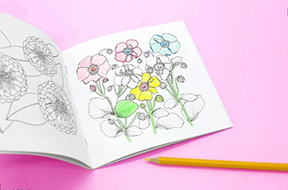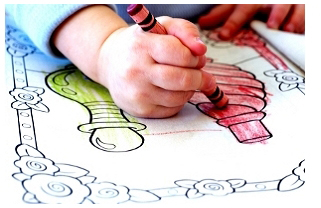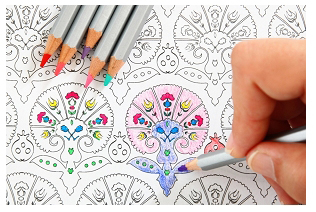Seven Things to Consider when Printing a Custom Coloring Book
|
|---|
Coloring Books are produced by organizations and individuals for a variety of reasons. Some plan to sell their coloring books in stores or online, others develop the books for promotional campaigns or fundraising efforts. Regardless of the intended purpose, it is imperative that you familiarize yourself with the printing phase of your coloring book before getting too deep into the design and layout phases.
Whether the coloring book contains simple outlines for children or more involved illustrations for adults, the actual printing will be one of the last steps in bringing the coloring book to life. However, it is important to learn as much about the printing stage as early as possible.
With that in mind, below is a list of seven things that will have an effect on the appearance, function, and cost of your coloring book…
1) Binding Style -
Coloring Books are typically bound with the Saddle-Stitch method or the Perfect Binding method. In most cases, the binding style you choose will be dictated by the number of pages in your coloring book.
If the page count is relatively low, the Saddle-Stitch method is recommended. Saddle-stitched coloring books are constructed from folded sheets that are held together by wire staples. The staples are driven through the crease of the coloring book's spine to secure the pages as a unit. Though  simple, the saddle-stitch method produces a very clean and professional appearance.
simple, the saddle-stitch method produces a very clean and professional appearance.
In addition, saddle-stitching is the most economical binding option. It also allows the coloring book to lie fairly flat when opened. This works well for designs that span two adjacent pages.
If the coloring book has a relatively high page count, the Perfect Binding method is recommended. Perfect Bound coloring books are created by gluing the pages and cover together at the spine with a strong, flexible glue. The other three sides of the book are then trimmed as needed to give them clean
"perfect" edges. Also, unlike the saddle-stitch method, perfect binding often allows for printing on the coloring book's spine.
A couple lesser-used options are the Spiral Coil and Wire-O Binding methods. Usually reserved for premium coloring books, these user-friendly methods allow the book to open a full 360 degrees (cover to cover). This feature enables the book to lie perfectly flat while in the open position…thus eliminating the need to continually hold the book open in order to color in it. Though the spine cannot be printed upon, these methods are able to accommodate books of varying thicknesses.
2) Dimensions -
The dimensions refer to the width and height of the coloring book in its finished form (also known as the trim size). Though coloring books can be printed in just about any size you choose - from pocket size to jumbo - bear in mind that all commercial printers have certain page sizes they offer as standard sizes.
These standard sizes are determined by the type of production equipment used by the printer. Designing your coloring book's page size to conform to one of your printer's standard page sizes will optimize the production of your coloring book and keep the cost as low as possible.
In contrast, a coloring book designed with non-standard page dimensions may not match well with any of your printer's presses. As a result, the production run would be inefficient and have a poor paper yield. The excess paper becomes waste and could add quite substantially to the cost of your production run.
Needless to say, knowing which page sizes your printer can produce most economically is good information to have before starting on the design and layout of your coloring book. A few subtle changes upfront could translate to big savings later, so be sure to get your printer involved early in the process.
3) Quantity -
The quantity of coloring books will determine the type of printing press best suited for producing the project. For example, if you only need 200 or 300 copies of your coloring book, you will generally achieve a lower unit cost by printing your books with a digital printing press. This is because a digital printing press has minimal set-up costs associated with a production run. An offset press, on the other hand, has higher set-up costs which cannot be efficiently distributed across a small production run.
However, as the order quantity increases, to say 500 or more, offset printing becomes the more economical production method. Even though the set-up cost of offset printing is higher, a larger order allows this cost to be distributed across more books. And once an offset press is running, the actual cost of applying ink to paper is substantially less than a digital press.
Incidentally, just because the unit cost of a book decreases as the order quantity increases, it is still wise to consider which run size is optimal for your specific situation. A lower unit cost is great, but not if you're ordering more coloring books than you'll ultimately need.
4) Page Count -
In addition to determining the binding style, the page count of your coloring book (along with the total quantity of coloring books needed) will help your printer calculate how much paper is needed to produce your project.
By the way, when relaying the page count to your printer, be sure not to confuse sheets with pages. Basically, every sheet within the book represents two pages.  Even if a sheet in the book is blank on one side, or is blank on both sides, your printer will count it as two pages. Thus, there will always be twice as many pages as there are sheets within a book. 100 sheets = 200 pages.
Even if a sheet in the book is blank on one side, or is blank on both sides, your printer will count it as two pages. Thus, there will always be twice as many pages as there are sheets within a book. 100 sheets = 200 pages.
Hence, all books contain an even number of pages. Not all of the pages in the book may be printed upon necessarily, or have printed page numbers, but the page count will always be even. Another thing to keep in mind about a saddle-stitched book is the page count must always be in multiples of four. This is because saddle-stitched books are created from folded sheets.
For example, if a saddle-stitched coloring book has a finished size of 8.5" x 11" and contains 20 interior pages, these pages would be created by folding five 17" x 11" sheets in half, nesting them together, and then securing the folded spine with staples. Each 17" x 11" sheet creates four 8.5" x 11" pages.
5) Ink Colors -
To provide maximum visual impact and perceived value, most coloring books are produced with a full-color cover. Conversely, the line art on the interior pages is almost always printed in black ink or grayscale.
Also, on the majority of coloring books, the ink on the front cover extends all the way to the edge of the cover. This is known as a Bleed and requires the cover artwork to be created slightly larger than the finished trim size of the book. Crop marks will also need to be added, so your printer will know exactly where to trim off the sections that bleed. The interior pages of a coloring book may or may not have a bleed. Bleed can be a confusing concept, so if you have any questions check with your printer before getting too far along in the design phase.
6) Paper Characteristics -
For durability, the cover of a coloring book is usually printed on stock that is somewhat heavier than the interior pages. To further boost the longevity of the cover, it is often produced with a clear overcoat, such as an aqueous or gloss UV coating. For the ultimate protection against wear and tear, a clear laminate film can be applied to the cover. In addition to durability, a gloss coating adds sheen and vibrancy to the ink colors.
Because the pages of a coloring book are designed to be filled in, they are usually created from an uncoated paper stock that has enough surface texture to "pull" the color off crayons, colored pencils, and other drawing media. Also, the interior pages of a coloring book should be opaque, so that the images do not easily show through from one side to the other.
Some saddle-stitched coloring books are made with covers that have the same paper type and thickness as the interior pages. This is referred to as a "self-cover" book. Though the cover will be less durable, this method is sometimes used to reduce costs.
7) Finishing Operations -
Finishing refers to value-added operations that are performed after the ink has been applied to the paper. Most finishing services are optional. Perforating, corner rounding, and shrink-wrapping are examples of finishing steps that often appeal to those creating a coloring book.
Perforating is a procedure that creates a series of very fine holes in paper, usually along a straight line, to allow a portion of the printed piece to be easily detached by hand. Some coloring book pages are created with perforations near the spine so that each page can be easily removed, if desired. This allows a page to be taken to a separate work surface for coloring, or to be individually displayed once it has been colored.
Corner Rounding is recommended whenever the combined features of the book produce a degree of rigidity, such as when a heavy card stock and/or thick laminated cover is used. A sharp 90-degree corner is more likely to pose a hazard during handling, so corner rounding is used to minimize this possibility. Corner rounding is especially recommended for coloring books intended for use by children.
Shrink-wrapping is a packaging method that encloses printed matter within a transparent plastic film. The application of heat makes the film shrink around the printing to secure it tightly. In addition to providing a layer of protection, shrink-wrapping is a cost-effective way to create convenient-sized packs of coloring books, allowing for easier handling, storage, and distribution. Coloring books can also be shrink-wrapped individually.
Get a Instant Price Quote...

 Adult Coloring Books have seen a tremendous increase in popularity as a means to relax and relieve stress ...
Adult Coloring Books have seen a tremendous increase in popularity as a means to relax and relieve stress ...